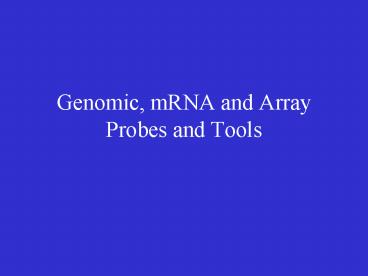Genomic, mRNA and Array Probes and Tools - PowerPoint PPT Presentation
1 / 25
Title: Genomic, mRNA and Array Probes and Tools
1
Genomic, mRNA and Array Probes and Tools
2
Human Genome Project and Competitors
- Human genome project --NIH, etc
- Full sequence by 2003-2005
- Including genes and other Genomics regions
- Incyte
- 140,000 genes, in process, IP problems
- Celera
- Interesting approach-- overlapping clones
- IP problems
- July, 00?
3
Expressed Sequence Tag
AAAAAAA
3 UT
5 UT
TTTTTTTT
EST
4
Hybridization
A C A T T G C G
T G T A A C G C
5
(No Transcript)
6
(No Transcript)
7
Selecting Genes to Pursue
- Consistent Responsiveness of the Gene to the
Illness across Subjects. - Pattern of Responsiveness of the Gene across
Brain Regions. - Type of Protein which is Encoded by the Gene.
- Presence of an Understandable Profile of Altered
Regulation as Part of an Ensemble. - Additional Considerations
- Existence of Allelic Variants
- Modulation by Antidepressants in Animals
- Selective Effects in Specific Types of Depression
8
Gene Array Analysis form Hypothalamus of
Antidepressant Treated Rats
Gene A
Gene B
Gene C
Gene D
Gene E
Gene F
Gene G
Saline
Saline
Bupropion
Fluoxetine
9
GAPIII mRNA In Situ Hybridization
Gene Array GAP III
saline
165
fluoxetine
10
Overview of µMArray System
- Research Genetics Sequenced Verified Clones- Rat,
Mouse and Human-Funded by the U of Michigan - One EST per Unigene Cluster-- an interesting and
moving target--Number of Genes, Cost, Variable
Arrays... - Mother Node is MHRI and Psychiatry
- STS Human Probes from Stanford Human Genome
Center - Co-Directed by Thompson and Meng
11
(No Transcript)
12
(No Transcript)
13
(No Transcript)
14
Overview of µMArray System
Research Investigators
cDNA clones from RG
Data entry, retrieval and analysis via Web
interface
Clone Management
Clone Replication
MARRAY Database (Oracle 8i)
Image Processing Software
Data Uploading
PCR products
Retrieve Raw Images
ARRAY
Glass Slides
Array Hybridization
Raw image files
Cye3/Cye5-labeled cDNA Probes
mRNA from candidate tissues
Note Process FlowData Flow
15
Bioinformatics and Special Chips
- Need ANY Help We Can Get
- U of M is Looking into Deals with Affymetrix,
Celera and Incyte. Huda and I are the Hosts/Lead. - Use all Public Data Sources
- Plan Studies of Circuits and Systems to See How
They Actually Function - Stanford Guidance
- Debbie Yu and Bay City Capital-Technical Advise
16
Aim II Genetic Studies
- Studies of Candidate Genes in Families and
Population Isolates.
17
(No Transcript)
18
David Cox is Head of the Stanford Genome Center.
19
Affymetrix Chips
- mRNA Expression
- Sequencing By Hybridization
- Drug Metabolism Data
20
(No Transcript)
21
Aim III Neurobiological Studies
- Rodent Studies
- Anatomical Mapping and Relation to Other Relevant
Molecules - Structure/Function Analysis of Protein Products.
- Regulatory Studies in Vivo
- Genetic Studies Using Transgenics, Knockouts and
Induceable Systems. - Primate Studies
22
Basic Neuroscience Models
- Richest dataset we havemany decades of
cumulative experience - Rodent behavioral, anatomical-circuit, molecular
and pharmacological studies - Primate- excellent tool for studying human
fundamentals - Stanford colony- superb behavioral and genetic
colony-for all classes of studies - Michigan/NIH Alcohol Institute- postmortem study
of selected primate brain
23
Technical Update and Changes
- Invader Assay (Stanford, Cox) very sensitive
and specific. Added this year to the tools we
plan to use following Arrays - Shifted Arrays to the U of M Array Lab.
- Internally readjusted work load and finances No
change in global budget - This process of technology evaluation will be an
annual feature of our scientific and budget
process
24
Consortium Agreement and IP Issues
- Nothing is signed, awaiting a common document.
- Scope of Work for all 5 years and 4 sites and a
firm Year 1 budget for each site has been
prepared. - U of M has completed its edits and has verbally
agreed. - Stanford seems to be in process.
- UC system has many issues. Tom Barton and the U
of M office are working with the UC staff to
explain it.
25
Relationships Between the Consortium and the
Network
- Overlap between the two sets of scientists, with
additional scientific skills available from each
system. - Report of the Consortiums progress to the
Network at the spring meeting. - Sees the two systems as part of the same
Foundation structure. - Natural and preferred collaborators.































